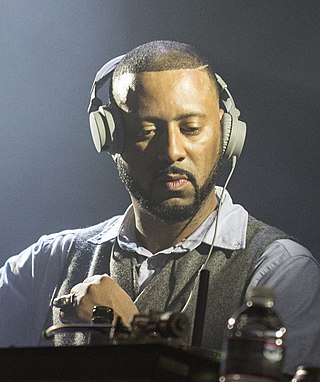Mixmaster Morris is an English electronica DJ and underground musician who has also recorded as The Irresistible Force. His work in the 1990s blended ambient music and chill-out influences with UK dance styles.
Trip hop is a musical genre that originated in the late 1980s in the United Kingdom, especially Bristol. It has been described as a psychedelic fusion of hip hop and electronica with slow tempos and an atmospheric sound, often incorporating elements of jazz, soul, funk, reggae, dub, R&B, and other forms of electronic music, as well as sampling from movie soundtracks and other eclectic sources.

Ambient music is a genre of music that emphasizes tone and atmosphere over traditional musical structure or rhythm. It may lack net composition, beat, or structured melody. It uses textural layers of sound that can reward both passive and active listening and encourage a sense of calm or contemplation. The genre is said to evoke an "atmospheric", "visual", or "unobtrusive" quality. Nature soundscapes may be included, and the sounds of acoustic instruments such as the piano, strings and flute may be emulated through a synthesizer.
Electronica is both a broad group of electronic-based music styles intended for listening rather than strictly for dancing and a music scene that came to prominence in the early 1990s in the United Kingdom. In the United States, the term is mostly used to refer to electronic music generally.
Kruder & Dorfmeister, named after members Peter Kruder and Richard Dorfmeister, is an Austrian duo, known for their trip hop/downtempo remixes of pop, hip hop and drum and bass songs.
Pork Recordings is a record label based in Kingston upon Hull, East Yorkshire, England, that specialises in electronica, mostly in the downtempo or chill-out styles.
Chill-out is a loosely defined form of popular music characterized by slow tempos and relaxed moods. The definition of "chill-out music" has evolved throughout the decades, and generally refers to anything that might be identified as a modern type of easy listening.
Balearic beat, also known as Balearic house, Balearic, Ibiza house or Ibizan chillout, is an eclectic blend of DJ-led dance music that emerged in the mid-1980s. It later became the name of a more specific style of electronic dance/house music that was popular into the mid-1990s. Balearic beat was named for its popularity among European nightclub and beach rave patrons on the Balearic island of Ibiza, a popular tourist destination. Some dance music compilations referred to it as "the sound of Ibiza", even though many other, more aggressive and upbeat forms of dance music could be heard on the island, such as Balearic trance.
Peter Kruder is a Viennese artist, producer and DJ. Together with his partner Richard Dorfmeister he is the founder of the duo Kruder & Dorfmeister and the record label G-Stone Recordings. Since the release of the G-Stoned EP, Peter Kruder has produced a broad range of work.
The Heights of Abraham is an electronica collaboration based in Sheffield and Kingston upon Hull, Yorkshire in North-East England. Formed in the mid-1990s by Steve Cobby, Sim Lister and Jake Harries, they play electronica, ambient techno, and chill out.

The Cutler is an electronica collaboration from Kingston upon Hull, Yorkshire. Formed by Steve Cobby, formerly half of Fila Brazillia, and David 'Porky' Brennand, founder of Pork Recordings, they play electronica and Dub music.
Wonky is a subgenre of electronic music known primarily for its off-kilter or “unstable” beats, as well as its eclectic, colorful blend of genres including hip-hop, electro-funk, 8-bit, jazz fusion, glitch, and crunk. Artists associated with the style include Joker, Rustie, Hudson Mohawke, Zomby, and Flying Lotus. The genre includes the related styles of purple sound and aquacrunk.
The Chillout Project is a series of compilations featuring house, downtempo, and lounge music by various artists compiled and produced by Anton Ramos.

Give 'Em Enough Dope Volume One is a compilation album of music by various artists released in 1994 by British electronic label Wall of Sound as their first release. The idea for the album came when Wall of Sound's founder, Mark Jones, wanted to release a compilation of hard-to-find music by unsigned artists, with whom he had worked with via his distribution and pressing deals, so that the music could be heard by a wider audience. He picked his favourite such tracks which there was already an audience for and this became the compilation.

Lofi hip hop is a form of downtempo music that combines elements of hip hop and chill-out music. It was popularized in the 2010s on YouTube.




